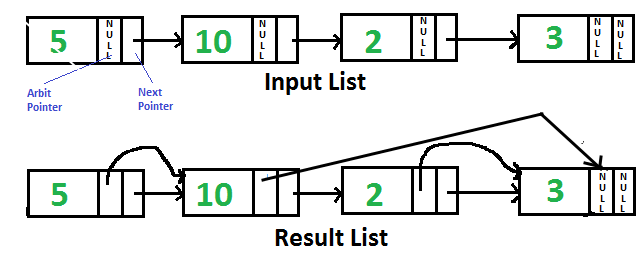Java Program For Pointing Arbit Pointer To Greatest Value Right Side Node In A Linked List
Last Updated :
03 May, 2023
Given singly linked list with every node having an additional “arbitrary” pointer that currently points to NULL. We need to make the “arbitrary” pointer to the greatest value node in a linked list on its right side.

A Simple Solution is to traverse all nodes one by one. For every node, find the node which has the greatest value on the right side and change the next pointer. The Time Complexity of this solution is O(n2).
An Efficient Solution can work in O(n) time. Below are the steps.
- Reverse the given linked list.
- Start traversing the linked list and store the maximum value node encountered so far. Make arbit of every node to point to max. If the data in the current node is more than the max node so far, update max.
- Reverse modified linked list and return head.
Following is the implementation of the above steps.
Java
class GfG{
static class Node
{
int data;
Node next, arbit;
}
static Node reverse(Node head)
{
Node prev = null,
current = head, next = null;
while (current != null)
{
next = current.next;
current.next = prev;
prev = current;
current = next;
}
return prev;
}
static Node populateArbit(Node head)
{
head = reverse(head);
Node max = head;
Node temp = head.next;
while (temp != null)
{
temp.arbit = max;
if (max.data < temp.data)
max = temp;
temp = temp.next;
}
return reverse(head);
}
static void printNextArbitPointers(Node node)
{
System.out.println("Node " +
"Next Pointer " +
"Arbit Pointer");
while (node != null)
{
System.out.print(node.data +
" ");
if (node.next != null)
System.out.print(node.next.data +
" ");
else
System.out.print("NULL" +
" ");
if (node.arbit != null)
System.out.print(node.arbit.data);
else
System.out.print("NULL");
System.out.println();
node = node.next;
}
}
static Node newNode(int data)
{
Node new_node = new Node();
new_node.data = data;
new_node.next = null;
return new_node;
}
public static void main(String[] args)
{
Node head = newNode(5);
head.next = newNode(10);
head.next.next = newNode(2);
head.next.next.next = newNode(3);
head = populateArbit(head);
System.out.println(
"Resultant Linked List is: ");
printNextArbitPointers(head);
}
}
|
Output:
Resultant Linked List is:
Node Next Pointer Arbit Pointer
5 10 10
10 2 3
2 3 3
3 NULL NULL
Time Complexity: O(n), where n is the number of nodes in the linked list.
Space Complexity: O(1). The algorithm uses a constant amount of extra space to store temporary variables during the traversal of the linked list.
Recursive Solution:
We can recursively reach the last node and traverse the linked list from the end. The recursive solution doesn’t require reversing the linked list. We can also use a stack in place of recursion to temporarily hold nodes. Thanks to Santosh Kumar Mishra for providing this solution.
Java
class GfG
{
static class Node
{
int data;
Node next, arbit;
}
static Node maxNode;
static void populateArbit(Node head)
{
if (head == null)
return;
if (head.next == null)
{
maxNode = head;
return;
}
populateArbit(head.next);
head.arbit = maxNode;
if (head.data > maxNode.data)
maxNode = head;
return;
}
static void printNextArbitPointers(Node node)
{
System.out.println("Node " +
"Next Pointer " +
"Arbit Pointer");
while (node != null)
{
System.out.print(node.data +
" ");
if (node.next != null)
System.out.print(node.next.data +
" ");
else
System.out.print("NULL" +
" ");
if (node.arbit != null)
System.out.print(node.arbit.data);
else
System.out.print("NULL");
System.out.println();
node = node.next;
}
}
static Node newNode(int data)
{
Node new_node = new Node();
new_node.data = data;
new_node.next = null;
return new_node;
}
public static void main(String[] args)
{
Node head = newNode(5);
head.next = newNode(10);
head.next.next = newNode(2);
head.next.next.next = newNode(3);
populateArbit(head);
System.out.println(
"Resultant Linked List is: ");
printNextArbitPointers(head);
}
}
|
Output:
Resultant Linked List is:
Node Next Pointer Arbit Pointer
5 10 10
10 2 3
2 3 3
3 NULL NULL
Time complexity: The time complexity of the populateArbit() function is O(n), where n is the number of nodes in the linked list.
Space complexity: The space complexity of the program is O(n), where n is the number of nodes in the linked list.
Please refer complete article on Point arbit pointer to greatest value right side node in a linked list for more details!
Like Article
Suggest improvement
Share your thoughts in the comments
Please Login to comment...